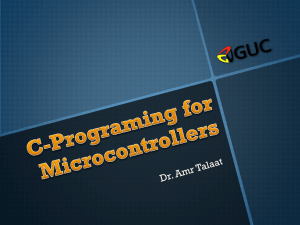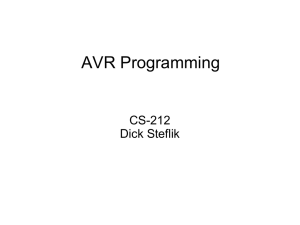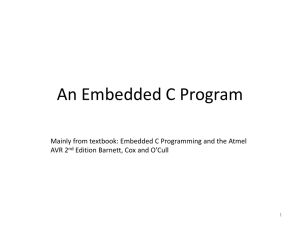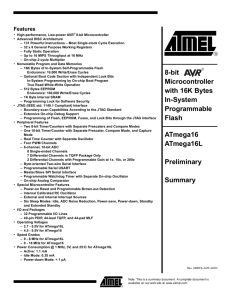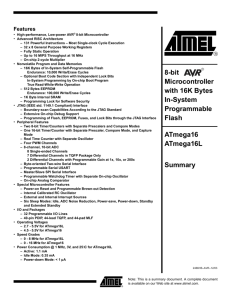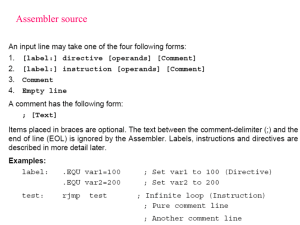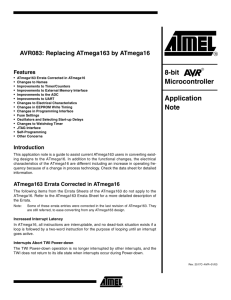i = 1
advertisement
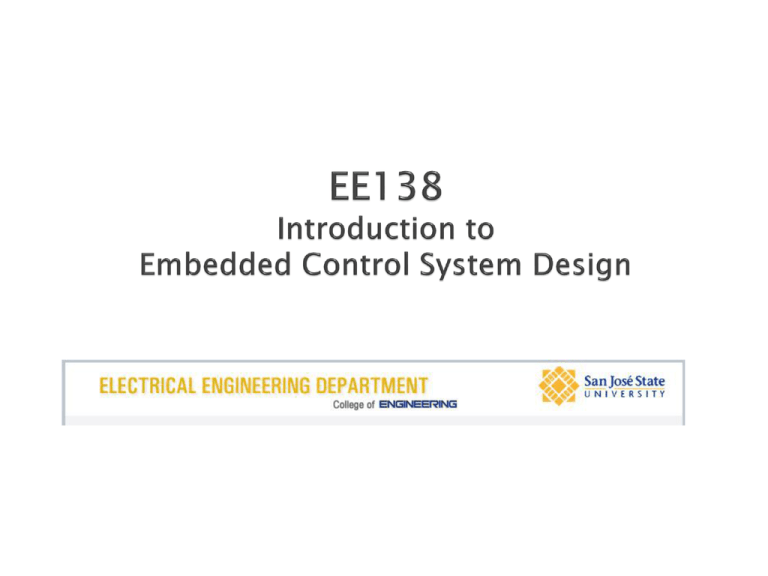
Overview of Micro-controller market
Overview of Atmel ATmega16 & AT91SAMD20
Overview of Atmel Development Kit STK500
C Development using Atmel AVR Studio 6.0
Quick review of C development with focus in
micro-controller programming
ATmega16 Digital I/O
2
2011 and 2010 worldwide microcontroller
revenue share by supplier.
2011 microcontroller market report
18 April 2012
http://www.dataweek.co.za/article.aspx?pklarticleid=7412
3
Different price bands for different applications and
markets
Microcontrollers in the 8-bit AVR family share a similar
instruction set and architecture.
The ATmega16 has components that are useful for
typical microcontroller applications, such as
◦
◦
◦
◦
◦
Digital IO
Serial communications
Interrupts, Timers
Pulse-width-modulator.
Analog-to-digital converter
STK500 Development Kit
•Atmega16
SAMD20 Explnd Pro Eval Kit
•AT91 SAM D20 (*NEW*)
5
AT91 SAMD20 (32-bit)
ATmega16 (8-bit)
Number of instructions
56
131
Flash program memory
256/128/64/32/16K
16K
Internal SRAM
32/16/8/4/2K bytes
1K bytes
EEPROM
None
512 bytes
General-purpose registers
17 x 32-bit
32 x 8-bit
GPIO pins
26..52
32
Serial interfaces
SPI, USART, I2C
SPI, USART, Two-wire
Timers
eight 8/16/32-bit
two 8-bit, one 16-bit
PWM
8 channels
4 channels
DAC
10-bit
None
ADC
Analogue comparator, Analogue comparator,
20-channel 12-bit ADC 8-channel 10-bit ADC
Interrupt vectors
32
21
6
7
Timers
Port C
Port A
Interrupt
Serial
Port D
Port B
CPU
ADC
8
9
Port A
Port B
Port D
Port C
10
11
EE138 – SJSU
12
13
Why using C?
C is a high-level programming language: C code is
easier to understand compared to other languages.
C supports low-level programming: We can use C to access all
hardware components of the microcontroller.
C has standard libraries for complex tasks: data type conversions,
standard input/output, long-integer arithmetic.
The Atmel AVR instruction set is designed to support C compilers: C
code can be converted efficiently to assembly code.
14
We need two tools for C development: Atmel AVR Studio and WinAVR.
Atmel AVR Studio
An integrated development environment for Atmel AVR
microcontroller.
It includes editor, assembler, emulator, HEX file downloader.
Available at: www.atmel.com/tools/studioarchive.aspx
WinAVR
A C compiler for AVR microcontrollers.
Can be used alone, or as a plug-in for Atmel AVR Studio.
Available at: winavr.sourceforge.net
Download setup files for Atmel AVR Studio and WinAVR
• Run setup file for Atmel AVR Studio. Accept default options
• Run setup file for WinAVR. Accept default options
15
Step 1: Create AVR Studio project
◦ project name
◦ project type C
◦ select simulator and device
Step 2: Enter a C program.
Step 3: Compile the C program to produce a HEX file.
Step 4: Download and test the HEX file on Atmel AVR microcontroller.
We’ll illustrate these steps using an example.
16
A program that lets user turn on LED by pressing a switch.
Video demo: Lab1_AVR6_LED
17
Start the AVR Studio program.
Select menu Project | New Project.
Click ‘Next’.
◦
◦
◦
◦
◦
project type: AVR GCC
project name: led
project location: C:\AVR
option ‘Create initial file’
option ‘Create folder’
18
Select
debug
platform
and device.
◦ debug
platform:
AVR
Simulator
◦ device:
ATmega16
Click
‘Finish’.
19
project files
program
led.c
status
messages
The AVR Studio window.
20
c
/* File: led.c
Description: Simple C program for the ATMEL AVR uC (ATmega16 chip)
It lets user turn on LEDs by pressing the switches on STK500 board
*/
#include <avr/io.h>
// AVR header file for all registers/pins
int main(void){
unsigned char i;
// temporary variable
DDRA = 0x00;
DDRB = 0xFF;
PORTB = 0x00;
// set PORTA for input
// set PORTB for output
// turn ON all LEDs initially
while(1){
// Read input from PORTA.
// This port will be connected to the 8 switches
i = PINA;
// Send output to PORTB.
// This port will be connected to the 8 LEDs
PORTB = i;
}
return 1;
}
21
Select menu Build | Build to generate HEX file led.c.
22
PORTA to
switches
power switch
12-V power
supply
ATmega16
chip
serial cable
to PC
programming
mode
PORTB to LEDs
Hardware setup for example program.
Connections to PORTA & PORTB are only for this example.
23
Select menu Tools |
Program AVR |
Connect.
Select platform and
port.
◦ ‘STK500 or AVRISP’
◦ ‘Auto’
Click ‘Connect’.
24
Select Input HEX file,
generated in Step 3.
Click ‘Program’.
After this, the
program is
downloaded to the
STK500 board and
runs.
The program
remains even after
power-off. To erase,
click ‘Erase Device’.
25
A C program typically has two main sections.
Section #include: to insert header files.
Section main():
code that runs when the program starts.
In this example, header file <avr/io.h> contains all register definitions
for the selected AVR microcontroller.
#include <avr/io.h> // avr header file for all registers/pins
int main(void){
unsigned char i; // temporary variable
DDRA = 0x00;
// set PORTA for input
DDRB = 0xFF;
// set PORTB for output
PORTB = 0x00;
// turn ON all LEDs initially
while(1){
// Read input from PORTA, which is connected to the 8 switches
i = PINA;
// Send output to PORTB, which is connected to the 8 LEDs
PORTB = i;
}
return 1;
}
26
Comments are text that the compiler ignores.
For a single-line comment, use double forward slashes:
DDRA = 0x00;
// set PORTA for input
For a multi-line comment, use the pair /* and */:
/* File: led.c
Description: Simple C program for the ATMEL AVR(ATmega16 chip)
It lets user turn on LEDs by pressing the switches on the STK500
board
*/
Always use comments to make program easy to understand.
27
C statements
◦ C statements control the program flow.
◦ They consist of keywords, expressions and other
statements.
◦ A statement ends with semicolon.
DDRB = 0xFF;
// set PORTB for output
C blocks
A C block is a group of statements enclosed by braces {}.
It is typically associated with if, switch, for, do, while, or functions.
while (1){
// Read input from PORTA - connected to the 8 switches
i = PINA;
// Send output to PORTB - connected to the 8 LEDs
PORTB = i;
}
28
The main data types in C are
char:
8-bit integer in AVR
int:
16-bit integer in AVR
long int:
32-bit integer in AVR
The above data types can be modified by keyword ‘unsigned’.
char a;
// range of values for a: -128, …, 0, …, 127
unsigned char b;
// range of values for b: 0, 1, 2, …, 255
unsigned long int c; // range of values for c: 0, 1, …, 232 - 1
Examples of variable assignment:
a = 0xA0;
// enter value in hexadecimal format
a = 0b11110000;
// enter value in binary format
b = ‘1’;
// b stores ASCII code of character ‘1’
c = 2000ul;
// c stores an unsigned long integer 2000
29
C has a rich set of operators:
◦ Arithmetic operators
◦ Relational operators
◦ Logical operators
◦ Bit-wise operators
◦ Data access operators
◦ Miscellaneous operators
30
Operator
Name
Example
Description
*
Multiplication
x * y
Multiply x times y
/
Division
x / y
Divide x by y
%
Modulo
x % y
Remainder of x divided by y
+
Addition
x + y
Add x and y
-
Subtraction
x – y
Subtract y from x
x++
Increment x by 1 after using it
++x
Increment x by 1 before using it
x--
Decrement x by 1 after using it
--x
Decrement x by 1 before using it
-x
Negate x
++
Increment
--
Decrement
-
Negation
31
Name
Example
Description (Return a value of …
Greater than
x > 5
1 if x is greater than 5, 0 otherwise
Greater than or
equal to
x >=5
1 is x is greater than or equal to 5, 0 otherwise
Less than
x < y
1 if x is smaller than y, 0 otherwise
<=
Less than or
equal to
x <= y
1 is x is smaller than or equal to y, 0 otherwise
==
Equal to
x == y
1 is x is equal to y, 0 otherwise
!=
Not equal to
x != 4
1 is x is not equal to 4, 0 otherwise
Operator
>
>=
<
32
These operators are applied on logical variables or constants.
Name
Example
Description (Returns a value of …
!
Logical NOT
!x
1 if x is 0, otherwise 0
&&
Logical AND
x && y
1 is both x and y are 1, otherwise 0
||
Logical OR
x || y
0 if both x and y are 0, otherwise 1
Operator
33
These operators are applied on individual bits of a variable or constant.
Operator
Name
Example
Description
~
Bit-wise
complement
~x
Toggle every bit from 0 to 1, or 1 to 0
&
Bitwise AND
x & y
Bitwise AND of x and y
|
Bitwise OR
x | y
Bitwise OR of x and y
^
Bitwise XOR
x ^ y
Bitwise XOR of x and y
<<
Shift left
x << 3
Shift bits in x three positions to the left
>>
Shift right
x >> 1
Shift bits in x one position to the right
34
These operators are for arrays, structures or pointers.
We’ll learn more about them when required.
Operator
Name
Example
Description
Array element
x[2]
Third element of array x
&
Address of
&x
Address of the memory location where
variable x is stored
*
Indirection
*p
Content of memory location pointed by p
.
Member selection
x.age
Field ‘age’ of structure variable x
->
Member selection
p->age
Field ‘age’ of structure pointer p
[]
35
Operator
()
(type)
Name
Example
Description
Function
_delay_ms(250)
Call a library function to create a
delay of 250ms
char x = 3;
x is 8-bit integer
(int) x
x is converted to 16-bit integer
Type cast
This is equivalent to
?
Conditional
evaluation
if (x > 5)
char x;
y = (x > 5)?10:20;
y = 10;
else
y = 20;
commonly used by C coders.
36
By default, C statements are executed sequentially.
To change the program flow, there are six types of statements
if-else statement
switch statement
Conditional
while statement
for statement
Iterative
do statement
goto statement
Should be avoided!
37
General syntax
if (expression)
statement_1;
else
statement_2;
Example
char a, b, sum;
a = 4; b = -5;
sum = a + b;
if (sum < 0)
printf(“sum is negative”);
else if (sum > 0)
printf(“sum is positive”);
else
printf(“sum is zero”);
38
General syntax
switch (expression)
case constant_1:
statement_1;
break;
case constant_2:
statement_2;
break;
…
case constant_n:
statement_n;
break;
default:
statement_other;
}
Use ‘break’ to separate
different cases.
39
Lab 7: Find the bit pattern to display a digit on the 7-segment LED.
(a) 7 segments of the LED
(b) Bit assignment on the 8-pin connector
LED segment
DP
g
f
e
d
c
b
a
Bit number
7
6
5
4
3
2
1
0
To display ‘1’
0
0
0
0
0
1
1
0
To display ‘2’
0
1
0
1
1
0
1
1
40
unsigned char digit;
// input
unsigned char led_pattern;
// output
switch (digit)
case ‘0’:
led_pattern = 0b00111111;
break;
case ‘1’:
led_pattern = 0b00000110;
break;
case ‘2’:
led_pattern = 0b01011011;
break;
//you can complete more cases here...
default:
}
PORTB = led_pattern; // send to PORTB and 7-segment LED
41
General syntax
while (expression){
statements;
}
Example: Compute the sum of 1 + 2 + … + 10.
int sum, i;
i = 1; sum = 0;
while (i <= 10){
sum = sum + i;
i = i + 1;
}
42
General syntax
for (expression1; expression2; expression3){
statements;
}
◦ expression1 is run before the loop starts.
◦ expression2 is evaluated before each iteration.
◦ expression3 is run after each iteration.
Example: Compute the sum of 1 + 2 + … + 10.
int sum = 0;
for (int i = 1; i <= 10; i++){
sum = sum + i;
}
43
General syntax
do {
statements;
} while (expression);
Example: Compute the sum of 1 + 2 + … + 10.
int sum, i;
i = 1; sum = 0; // Initialization
do{
sum = sum + i;
i = i + 1;
} while (i <= 10);
44
The ‘break’ statement inside a loop forces early
termination of the loop.
What is the value of ‘sum’ after the following code is executed?
int sum, i;
i = 1; sum = 0;
while (i <= 10){
sum = sum + i;
i = i + 1;
if (i > 5)
break;
}
45
The ‘continue’ statement skips the subsequent
statements in the code block, and forces the execution
of the next iteration.
What is the value of ‘sum’ after the following code is executed?
int sum, i;
i = 1; sum = 0; // Initialization
while (i <= 10){
i = i + 1;
if (i < 5)
continue;
sum = sum + i;
}
46
An array is a list of values that have the same data type.
In C, array index starts from 0.
An array can be one-dimensional, two-dimensional or more.
This code example creates a 2-D array (multiplication table):
int a[8][10];
for (int i = 0; i < 8; i++)
for (int j = 0; i < 10; j++)
a[i][j]= i * j;
An array can be initialized when it is declared.
int b[3] = {4, 1, 10};
unsigned char keypad_key[3][4] = {{'1', '4', '7', '*'},
{'2', '5', '8', '0'},
{'3', '6', '9', '#'}};
47
C functions are sub-routines that can be called
from the main program or other functions.
Functions enable modular designs, code reuse, and hiding of
complex implementation details.
A C function can have a list of parameters and produce a return
value.
Let us study C functions through examples.
48
Write a function to compute the factorial n! for a given n.
// factorial is the name of the custom function
// it accepts an input n of type int, and return an output of type
int
int factorial(int n){
int prod = 1;
for (int i = 1; i <=n; i++)
prod = prod * i;
return prod;
// return the result
}
int main(void){
int n = 5;
// some example value of n
int v;
// variable to storage result
v = factorial(n); // call the function, store return value in v
return 1;
}
49
Write a function to compute the factorial n! for a given n.
// factorial is the name of the custom function
// it accepts an input n of type int,
// it stores output at memory location by int pointer p
void factorial(int n, int* p){
int prod = 1;
for (int i = 1; i <=n; i++)
prod = prod * i;
*p = prod;// store output at memory location pointed by p
}
int main(void){
int n = 5;
// some example value of n
int v;
// variable to storage result
factorial(n, &v); // call the function, store return value in
v
}
50
Optimize the C code for efficiency and length.
Delete unnecessary lines of code.
The C code must be properly formatted.
Use correct indentation to show the logical structure of the
program.
Use a blank line to separate code sections.
Use meaningful variable names and function names.
Use concise C comments to explain code.
For printing, use a fixed-width font such as Courier New for
code.
If a C statement is too long for one printed line, split it logically
into multiple lines.
Observe the way that C code is presented in the lecture notes or
lab notes.
51
ATmega16 has fours 8-bit digital IO ports:
◦
◦
◦
◦
PORT
PORT
PORT
PORT
A,
B,
C, and
D.
Each port has 8 data pins.
Every port is bi-directional.
output pin
input pin
Each of the 8 pins can be individually
configured as input or output.
external
devices
microcontroller
52
Port A
Port B
Port D
Port C
53
For each port, there are three relevant 8-bit registers.
Data Direction Register (DDRx)
Input Pins Address (PINx)
Data Register (PORTx)
Here, x denotes A, B, C or D.
Data Direction Register (DDRx) is used to configure a specific port
pin as output (1) or input (0).
Example: To set Port A pins 0 to 3 for input, pins 4 to 7 for output,
we write C code
DDRA = 0b11110000; // configure pins
bit
DDRA
7
6
5
1
1
1
for output
4
1
3
2
1
0
0
0
0
0
for input
54
Register Data Register (PORTx) is used to write output data to port.
Example: To write a binary 0 to output pin 6, binary 1 to other
pins of Port A, we write C code
PORTA = 0b10111111; // write output
Register Input Pins Address (PINx) is used to read input data from port.
Example: To read the input pins of Port A, we write C code
unsigned char temp; // temporary variable
temp = PINA;
// read input
Where do the C names PINA, PORTA, DDRA come
from?
// extract from header file <avr/iom16> …
#define PINA
_SFR_IO8(0x19)
#define DDRA
_SFR_IO8(0x1A)
#define PORTA
_SFR_IO8(0x1B)…
55
To access all AVR microcontroller registers, your
program must include the header file <io.h>, which is
found in the WinAVR folder.
#include <avr/io.h>
Depending on the device selected in your project, file ‘io.h’ will
automatically redirect to a specific header file.
Example
For ATmega16, the specific header file is ‘avr/iom16.h’.
This header file is printed in Appendix A of the lab notes.
It lists the C names and addresses for all ATmega16 registers.
We always use the C names in our code.
56
/* File: led.c
Description: Simple C program for the ATMEL AVR uC (ATmega16
chip)
It lets user turn on LEDs by pressing the switches on STK500
board
*/
#include <avr/io.h>
// AVR header file for all registers/pins
int main(void){
unsigned char i;
// temporary variable
DDRA = 0x00;
DDRB = 0xFF;
PORTB = 0x00;
// set PORTA for input
// set PORTB for output
// turn ON all LEDs initially
while(1){
// Read input from PORTA.
// This port will be connected to the 8 switches
i = PINA;
// Send output to PORTB.
// This port will be connected to the 8 LEDs
PORTB = i;
}
return 1;
}
Video demo: Lab1_7Segment
57
What we learned in this lecture:
◦ An overview of ATmega16.
◦ The tools and the steps for programming the Atmel
AVR.
◦ Basics about C programming.
◦ Programming the digital IO ports of ATmega16.
Special acknowledgement to
Dr. Lam Phung of University of Wollongong
for sharing his lecture notes and lab notes!
58
L. Phung, Lecture & Lab Notes,
◦ http://www.elec.uow.edu.au/avr/index.php
J. Pardue, C Programming for Microcontrollers, 2005,
SmileyMicros
◦
[Chapters 1-6].
S. F. Barrett and D. J. Pack, Atmel AVR Microcontroller
Primer: Programming and Interfacing, 2008, Morgan &
Claypool Publishers,
◦
[Chapter 1].
Atmel Material
◦ http://www.atmel.com/Images/doc2466.pdf
◦ http://www.atmel.com/devices/atmega8515.aspx?tab=
documents
◦ http://www.atmel.com/tools/STK500.aspx
STK500 User Guide
http://www.atmel.com/Images/doc1925.pdf
Atmel SAM D20 Datasheet
59

